Preventive Care
Preventive dental care is important throughout life, especially at a young age. By practicing good oral hygiene at home and scheduling regular checkups with the dentist, your child can help keep their smile bright and healthy for many years to come. Here are a few simple ways to prevent the build-up of plaque and cavities:
- Make sure your child brushes their teeth at least twice a day with a soft-bristled toothbrush. Use fluoride toothpaste to remove food particles and plaque from the tooth surfaces. Also be sure your child brushes the top surface of the tongue; this will remove any extra plaque-causing food particles and help keep their breath fresh!
- Make sure your child cleans between teeth by flossing at least once a day. You can also use a mouthwash to help kill bacteria and freshen breath. Decay-causing bacteria can linger between teeth where toothbrush bristles can't reach. Floss and mouthwash will help remove plaque and food particles from between the teeth and under the gum line.
- Make sure your child eats a balanced diet, and try to avoid extra-sugary treats. Nutritious foods such as raw vegetables, plain yogurt, cheese, or fruit can help keep your child's smile healthy.
- Remember to schedule regular checkups with your child’s dentist every six months for a professional teeth cleaning.
- Ask your dentist about dental sealants, a protective plastic coating that can be applied to the chewing surfaces of the back teeth where decay often starts.
- If your child plays sports, be sure to ask your dentist about special mouthguards designed to protect your child’s smile.
- Brushing Instructions
-
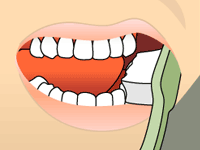
Brushing: Step 1
Place your toothbrush at a 45-degree angle to your gum.

Brushing: Step 2
Brush gently in a circular motion.
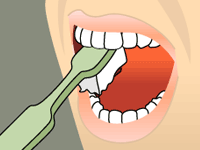
Brushing: Step 3
Brush the outer, inner, and chewing surfaces of each tooth.
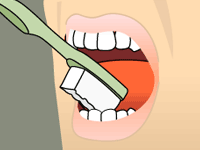
Brushing: Step 4
Use the tip of your brush for the inner surface of your front teeth.
- Flossing Instructions
-
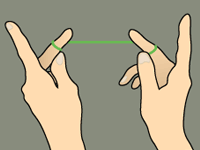
Flossing: Step 1
Wind about 18 inches of floss around your fingers as shown. Most of it should be wrapped around one finger, and the other finger takes it up as the floss is used.
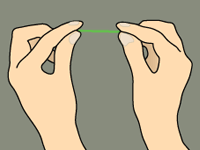
Flossing: Step 2
Use your thumbs and forefingers to guide about one inch of floss between your teeth.
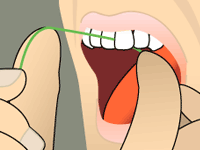
Flossing: Step 3
Holding the floss tightly, gently saw it between your teeth. Then curve the floss into a C-shape against one tooth and gently slide it beneath your gums.
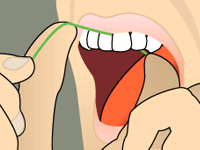
Flossing: Step 4
Slide the floss up and down, repeating for each tooth.
If it’s been six months or more since your child’s last dental checkup, then it’s time to contact our practice and schedule an appointment!
Nutrition and Oral Health
Establishing good nutritional habits for your child can be especially beneficial to promote good eating patterns and food choices for the rest of his or her life. Think of your child’s mouth as the doorway to the rest of the body. Whatever gets consumed not only affects your child’s growth, development, weight, and energy levels, but oral health as well. Eating a nutritious, balanced diet is vital for the development of strong, healthy teeth.
General Tips for a Healthy Diet and a Healthy Mouth
- Limit your child’s consumption of sugary foods and beverages. When plaque combines with the sugars and starches, an acid is produced that attacks enamel on the teeth, and eventually causes decay.
- Make sure your child’s diet includes a balance of fruits and vegetables, whole grains, protein, and dairy products. The nutrients found in these foods are important to his or her growth and health.
- Look for sugar in unexpected places. Many foods that make up a balanced, healthy diet contain sugar — including fruit, some vegetables, and milk. The best time to eat these is during meal time, not as a snack.
- Speaking of snacks, limit your child’s snacking to only a few per day, and make sure they’re nutritious!
- Fun foods, like candy and starchy snacks, should be reserved for special occasions, not everyday snacking.
- When he or she is old enough, let your child chew sugar-free gum that carries the ADA seal. Chewing sugar-free gum increases saliva flow, which washes away food debris and neutralizes acids produced by bacteria.
- Ensure your child brushes twice a day and flosses to eliminate food debris that leads to harmful plaque and bacteria, and causes tooth decay.
Thumb Sucking
Along with favorite blankets, teddy bears, and nap time, thumb-sucking can be one of the most comforting aspects of childhood. According to a recent report, between 75% and 95% of infants suck their thumbs, so chances are there’s a thumb-sucker (or a former thumb-sucker) in your family. Is this cause for worry?
In most cases, the answer is no. However, it’s important to pay attention to your child’s habits in case his or her behavior has the potential to affect overall oral health.
What is normal thumb-sucking behavior?
Most children begin sucking their thumbs or fingers from a very young age; many even start inside the womb. Sucking is a natural reflex for an infant and it serves an important purpose. Sucking often provides a sense of security and contentment for a young one. It can also be relaxing, which is why many children suck their thumbs as they fall asleep.
According to the American Dental Association, most children stop thumb-sucking on their own between the ages of two and four. They simply grow out of a habit that is no longer useful to them. However, some children continue sucking beyond the preschool years (although studies show that the older a child gets, the lower the chances are of continuing the habit). If your child is still sucking when his or her permanent teeth start to erupt, it may be time to take action to break the habit.
What signs should I watch for?
First, take note of how your child sucks his or her thumb. If the sucking is passive, with the thumb gently resting inside the mouth, it is less likely to cause damage. If, on the other hand, the thumb-sucking is aggressive, placing pressure on the mouth or teeth, the habit may cause problems with tooth alignment and proper mouth growth. Extended sucking affects both the teeth and the shape of the face and may lead to a need for orthodontic treatment in the future.
If at any time you suspect your child’s thumb-sucking may be affecting his or her oral health, please give us a call and schedule a visit. We can help you assess the situation.
How can I help my child quit thumb-sucking?
Should you need to help your child end the habit, follow these guidelines:
- Always be supportive and positive. Instead of punishing your child for thumb-sucking, give praise when he or she doesn’t.
- Put a band-aid on your child’s thumb or a sock over the hand at night. Let your little one know that this is not a punishment, but rather a way to help remember to avoid sucking.
- Start a progress chart and let your child put a sticker up every day that he or she doesn’t suck. If your child makes it through a week without sucking, he or she gets to choose a prize. When the whole month is full, reward your child with something great (a toy or new video game); by then the habit should be over. Making your child an active participant in his or her treatment will increase the willingness to break the habit.
- If you notice your child sucking when he or she is anxious, work on alleviating the anxiety rather than focusing on the thumb-sucking.
- Take note of the times your child tends to suck (long car rides, while watching movies) and create diversions during these occasions.
- Explain clearly what might happen to the teeth if he or she keeps thumb-sucking.
Whatever your method, always remember that your child needs your support and understanding during the process of breaking the habit of thumb-sucking.
Fillings
Traditional dental restoratives, or fillings, may include gold, porcelain, and composite. The strength and durability of traditional dental materials continue to make them useful for situations where restored teeth must withstand extreme forces that result from chewing, such as in the back of the mouth.
Newer dental fillings include ceramic and plastic compounds that mimic the appearance of natural teeth. These compounds, often called composite resins, are usually used on the front teeth where a natural appearance is important, as well as on the back teeth depending on the location and extent of the tooth decay.
What’s right for your child?
Several factors influence the performance, durability, longevity and expense of dental restorations, including:
- The components used in the filling material
- The amount of tooth structure remaining
- Where and how the filling is placed
- The chewing load that the tooth will have to bear
- The length and number of visits needed to prepare and adjust the restored tooth
Before your child’s treatment begins, your doctor will discuss all options and help you choose the best filling for your child’s particular case. It may be helpful to understand the two basic types of dental fillings: direct and indirect.
- Direct fillings are fillings placed immediately into a prepared cavity in a single visit. They include glass ionomers, resin ionomers, and composite (resin) fillings. The dentist prepares the tooth, places the filling and adjusts it in just one appointment.
- Indirect fillings generally require two or more visits. They include inlays, onlays, veneers, crowns, and bridges fabricated with gold, base metal alloys, ceramics, or composites. During the first visit, the dentist prepares the tooth and makes an impression of the area to be restored. The dentist then places a temporary covering over the prepared tooth. The impression is sent to a dental laboratory that creates the dental restoration. At the next appointment, the dentist cements the restoration into the prepared cavity and adjusts it as needed.
Fluoride
Your child brushes twice a day, flosses regularly, and visits the dentist every six months. But did you know that rinsing with fluoride – a mineral that helps prevent cavities and tooth decay – also helps keep teeth healthy and strong?
Fluoride is effective in preventing cavities and tooth decay by coating teeth and preventing plaque from building up and hardening on the tooth’s surface.
Fluoride comes in two varieties, systemic and topical:
- Systemic fluoride is ingested, usually through a public water supply. While teeth are forming under the gums, the fluoride strengthens tooth enamel, making it stronger and more resistant to cavities.
- Fluoride can also be applied topically to help prevent caries (cavities) on teeth present in the mouth. It is delivered through toothpaste, mouthwash, and professional fluoride applications. Professional application of topical fluoride foam and varnishes is also a valuable tool in cavity prevention.
Receiving a fluoride treatment from your dentist
A fluoride treatment in the dentist’s office takes just a few minutes. After the treatment, patients may be asked to not rinse, eat, or drink for at least 30 minutes in order to allow the teeth to absorb the fluoride. Depending on your child’s oral health or your doctor’s recommendation, your child may be required to have a fluoride treatment every three, six, or 12 months. Your doctor may also prescribe at-home fluoride products such as mouthwash, gels, or antibacterial rinses.
Sealants
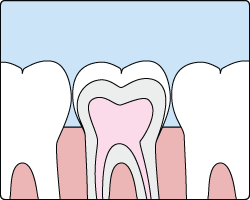
Sometimes brushing is not enough, especially when it comes to those hard-to-reach spots in your child’s mouth. It is difficult for a toothbrush to reach between the small cracks and grooves on teeth. If left alone, those tiny areas can develop tooth decay. Sealants give your child’s teeth extra protection against decay and help prevent cavities.
Dental sealants are plastic resins that bond and harden in the deep grooves on the tooth’s surface. When a tooth is sealed, the tiny grooves become smooth, and are less likely to harbor plaque. With sealants, brushing becomes easier and more effective against tooth decay.
Sealants are typically applied to children’s teeth after their permanent teeth have erupted as a preventive measure against tooth decay. It is more common to seal “permanent” teeth rather than “baby” teeth, but every patient has unique needs, and the dentist will recommend sealants on a case-by-case basis.
Sealants last from three to five years, although it is fairly common to see adults with sealants still intact from childhood. A dental sealant only provides protection when it is fully intact so if your child’s sealants come off, let the dentist know, and schedule an appointment for your child’s teeth to be re-sealed.